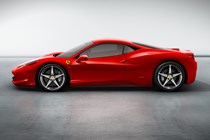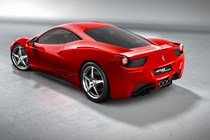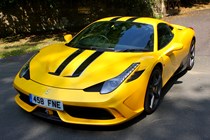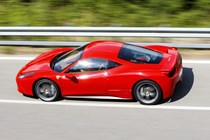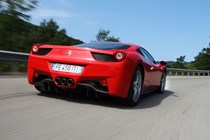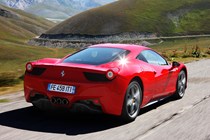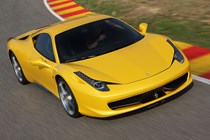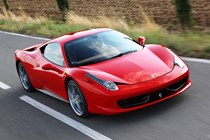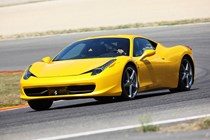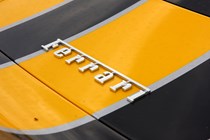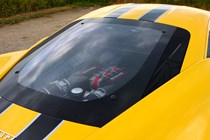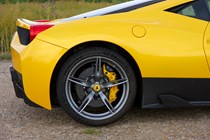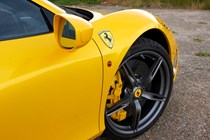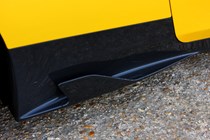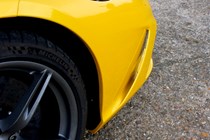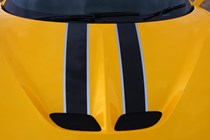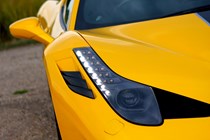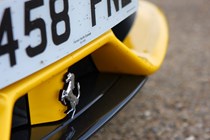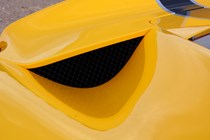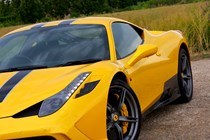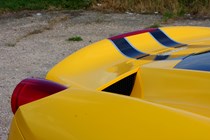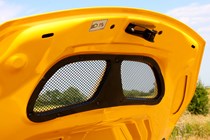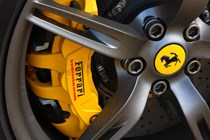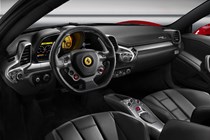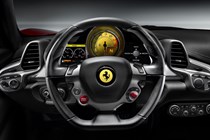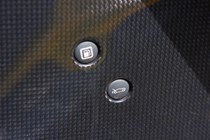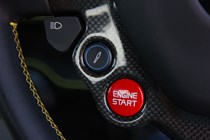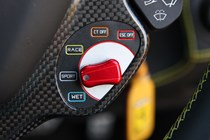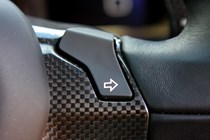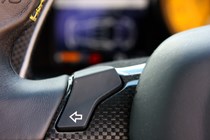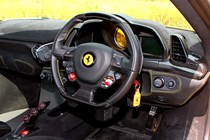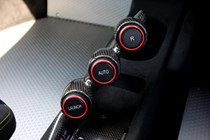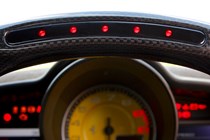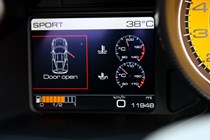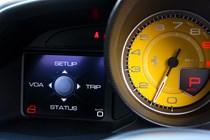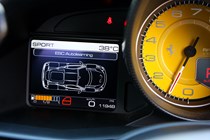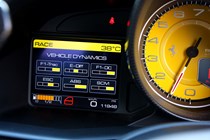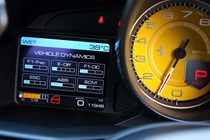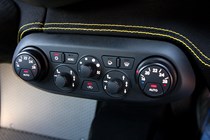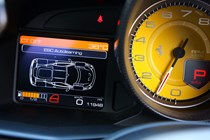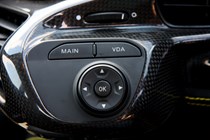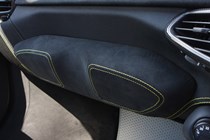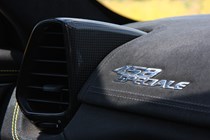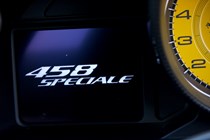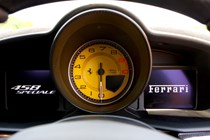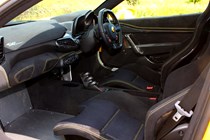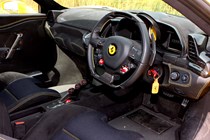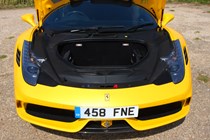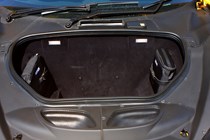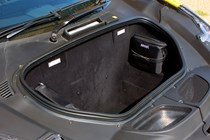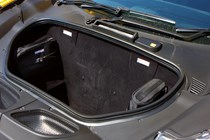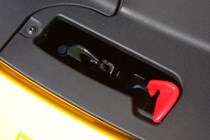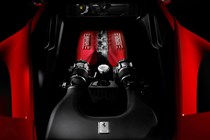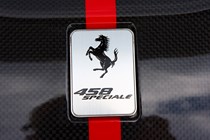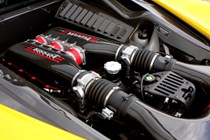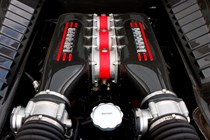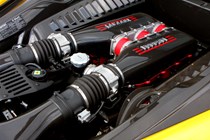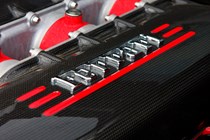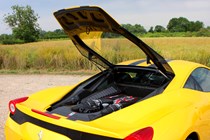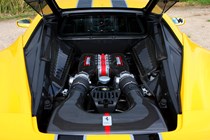
Ferrari 458 Coupe (2010-2016) engines, drive and performance
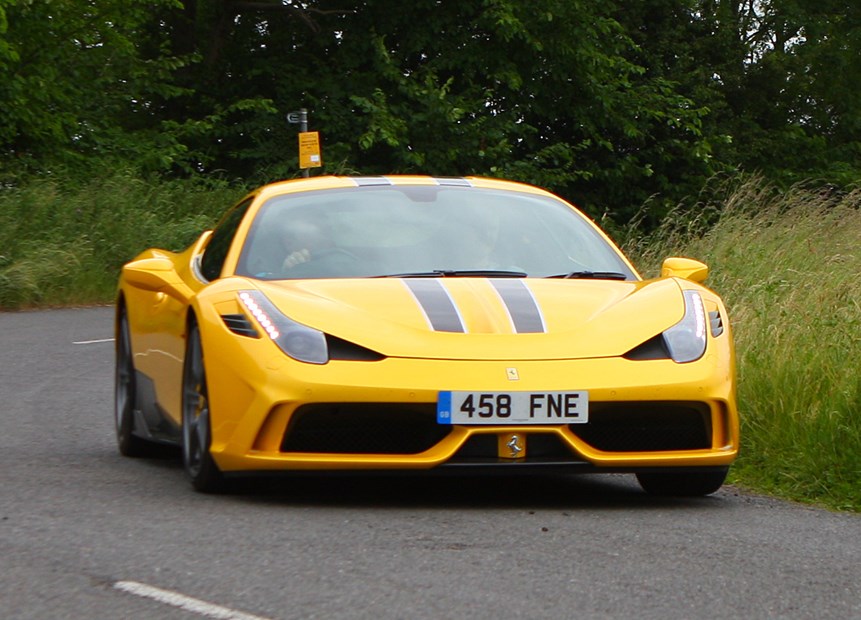
There are two engine outputs providing Ferrari 458 Italia performance depending on whether you select the standard 458 or opt for the more powerful (and lighter) 458 Speciale.
458 Italia
As the name suggests the 458 Italia uses a 4.5-litre V8, which is naturally aspirated and produces a healthy 562bhp at a heady 9,000rpm. Maximum torque – 540Nm – arrives just 3,000rpm earlier, and at first glance the 458 Italia looks to offer peaky performance, but that’s not how it plays out in reality.
Around 80 percent of that torque figure is on-stream from just 3,250rpm, so you’ve got just shy of 6,000rpm’s worth of powerband to take advantage of.
Do so, and scrabbling from 0-62mph takes just 3.4 seconds, and where permissible 124mph arrives on the digital speedometer just 10.4 seconds after launch. That’s startlingly quick, putting the Italia on a par with the Porsche 911 Turbo in terms of on-paper performance, but above Germany’s super-coupe for drama and emotion as it does so.
It certainly feels as fast as those numbers would suggest when you’re behind the wheel, frantically click-clacking the gearbox paddles that nestle neatly behind the wheel as you hope to select the next ratio before running into the limiter. However, while this engine rips through its range with disarming alacrity, the seven-speed Dual Clutch automatic gearbox happily matches it with an imperceptible let-up in forward motion. And if your fingers aren’t fast enough, you can of course leave it in automatic mode and let the car do the work for you.
458 Speciale
For the Ferrari 458 Speciale it’s business as usual in this department, just with everything turned up to eleven.
The new exhaust has a different routing, redesigned intake tract and different silencer configuration so the Speciale sounds louder and more purposeful from the off. Alongside the bark from the V8 at start up you’ll notice a fizz that emanates through the chassis and controls, filtering its excitement through to the driver. It’s not un-refined, simply a more involving place to sit than in the standard 458 Italia, and even at idle this model is as special as its name suggests.
And so it should be, as while it essentially uses the same 4.5-litre V8 engine found in the 458 Italia, there have been comprehensive updates to improve its performance – with consistency. So although peak torque remains the same, power jumps to 597bhp courtesy of modified pistons, shorter inlet ducts on the intake manifolds, increased lift on the valves and different cams.
To cope with the increase in power, parts of the pistons and rods are made from a new material and the crankshaft was redesigned, while the carbon fibre intake and aluminium exhaust helped with an 8kg weight loss for the powerplant.
All of that work means the Ferrari 458 Speciale can slingshot from 0-62mph in 3.0 seconds and to 124mph in just 9.1 seconds. That no longer puts it on a par with the Porsche 911 Turbo but the Turbo S, or even the near £300,000 McLaren 675LT.
Not that those rivals will enter your head when you experience the explosive performance of the Speciale on the road; always underlaid by that incredible barking V8, which soon gives way to a howling shriek as the revs are increased, the Speciale hurtles towards the horizon with ridiculous pace.
There’s an argument – and the 458 Italia could very well fall into the same trap – that’s it’s too fast for UK roads and that you need a race circuit to fully experience it. At times that certainly feels true, the biblical noise it makes merely interspersed with the ‘ping’ of stones and debris rattling off its flat underside as the gearbox thumps you in the back with the next up-change under full-throttle.
With no let-up in the power delivery the 458 Speciale does its best to find traction (which is less of an issue than you might expect) and turns long straights into mere moments of sensory relief between apexes. Driven fast it’s not difficult, but such is the level of commitment and concentration required from the driver you will feel exhausted after a particularly spirited drive. You’ll certainly appreciate the digital speedometer, as without you’ll have a hard job keeping track of the massive numbers that will soon appear under acceleration.
But unlike the grip-laden and uber-efficient Porsche 911 Turbo, the Speciale can perform at five tenths with just as much drama and excitement. The noise, low and deep early in the rev range, is loud enough to induce a grin even at speeds below 30mph – provided you’re in the correct gear of course. And nestled in the race seat, surrounded by carbon fibre and Alcantara, children staring in disbelief as you trundle past, even at low speed you can’t help but succumb to this car’s sense of occasion.
The F1 Dual Clutch automatic gearbox uses a new controller for even faster upshifts, resulting in 40 percent faster acceleration and even snappier downchanges. So the good news is the paddles are still fully articulated, clicking home with a satisfying action rather than the less-than-appealing haptic response of a button or switch so often experienced in rivals.
And while the Ferrari 458 Speciale will accelerate with absolute ferocity, should you change your mind about how fast you want to headbutt the horizon, the upgraded brakes (Ceramic discs, new calipers and special pads as well as extra cooling) result in a 62-0mph distance of just 31 metres. Under light pedal pressure they squeal and shriek like a race car, but when you really need them they provide immense stopping power with no perceptible performance degradation, even after multiple emergency stops.
If you want to drive the Ferrari 458 Italia or 458 Speciale quickly, the first thing you have to remember is that it’s a mid-rear-engined sportscar with just shy of 600bhp. That means it pays to give it some respect, and work your way through corners on a steady throttle rather than just blindly mashing the pedal to the floor before you’ve even passed the apex.
All that said, on the whole this is not a difficult car to drive, and provided you don’t do anything blindly stupid it won’t bite back. Much of that is down to the sophisticated E-Diff 3 and F1-Trac software – an electronic differential which shuffles torque between the rear wheels to whichever has most grip. It works more effectively with the F1-Trac system which monitors and adjusts the car’s attitude based on estimates of grip and driver input.
There are five modes available, all adjusted via the steering wheel-mounted Manettino switch, including Wet, Sport, Race, CT off (traction) and ESC off (stability control). Most of the time you’ll be happy with Sport, though Wet does give a larger safety net should the weather be on the inclement side, and really only when on track is it worth investigating either of the CT off or ESC off modes.
With the 458 Speciale you can add Side Slipangle Control (SSC) to that acronym list, which analyses the inputs of the driver including steering angle versus acceleration, yaw angle (how much the car is pivoting) and speed. If it decides you’re fully in control it will permit the car to slide into power oversteer and will optimise torque output for the smoothest manoeuvre possible.
Regardless of which model you choose, both exhibit especially light steering. If it’s your first experience of a Ferrari you’ll likely be surprised and slightly disconcerted by the lack of weight in the helm, and struggle to decipher the information being fed back through it. But it’s clearly there, and once you gel with the weighting, which seems to sharpen the responses of the car, it’s easy to trust in the front axle.
Grip is immense, and you’ll be able to travel far faster than the posted speedlimits for any serious corner without any leap of faith on your behalf. The level of lateral adhesion is spread between the axles too, and while the 458 feels incredibly agile it never falls foul of instability or nervousness.
There’s a slight sliver of bodyroll when nearing the limit, to help communicate just how close you are getting, but pitch and dive are noticeable by their complete absence. As we’ve mentioned, jump onto the gas too early and there’ll be a squirm from the rear end as the considerable rear rubber fights for traction and the tail tries to swing wide, but with the stability control system engaged the 458 quickly gathers up any exuberance.
Most of the time you’ll run the car with Bumpy Road suspension mode engaged, at least across the broken blacktop that makes up most of the UK’s road networks, and you’ll appreciate just how comfortable this sports car really is. In fact it’s remarkable just how much the 458 can smother beneath its tyres, even in the more focussed 458 Speciale riding on forged 20-inch wheels – which are 12kg lighter than the standard 458 Italia’s. Along with the excellent seats, this supple ride quality ensures the 458 is perfect for long distance trips without any major fatigue.




